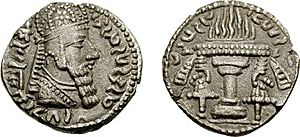Ardashir I facts for kids
Quick facts for kids Ardashir I𐭠𐭥𐭲𐭧𐭱𐭲𐭥 |
|
|---|---|
| King of Kings of Iran | |
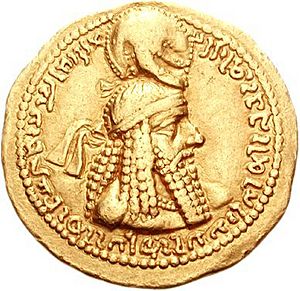
Gold dinar of Ardashir I, 230 AD
|
|
| King of Persis | |
| Reign | 211/2–224 |
| Predecessor | Shapur |
| Successor | Office abolished |
| Shahanshah of the Sasanian Empire | |
| Reign | 224–242 |
| Coronation | 226 Ctesiphon |
| Predecessor | Artabanus IV (Parthian Empire) |
| Successor | Shapur I |
| Co-ruler | Shapur I (240–242) |
| Born | Unknown Tiruda, Khir, Pars |
| Died | February 242 |
| Spouse | Denag Murrod |
| Issue | Shapur I |
| House | House of Sasan |
| Father | Pabag or Sasan |
| Mother | Rodag |
| Religion | Zoroastrianism |
Ardashir I (180–242 AD) was a powerful ruler who founded the Sasanian Empire. He is also known as Ardashir the Unifier. Before starting his new empire, he was Ardashir V, a local king in a region called Persis.
In 224 AD, Ardashir defeated Artabanus IV, the last king of the Parthian Empire, in a big battle at Hormozdgan. This victory ended the Parthian dynasty. Ardashir then started the Sasanian dynasty and called himself "shahanshah," which means "King of Kings." He began to conquer lands and unite them under a new name: Iran.
There are different stories about Ardashir's family. Some say he was the son of Papak and grandson of Sasan. Other stories suggest he was born from the marriage of Sasan, who was a descendant of the ancient king Darius III, and Papak's daughter. Papak was a local governor in the region of Pars.
According to one account, Ardashir was born near Istakhr in Pars. When he was seven, he was sent to live with the lord of Fort Darabgard. After the lord died, Ardashir took his place as commander. Later, Papak, Ardashir's father, overthrew the local Persian king, Gochihr, and put his other son, Shapur, in charge. However, both Papak and Shapur died suddenly, and Ardashir became the ruler of Pars. This led to conflict with the Parthian Empire, ending in the battle where Ardashir defeated Artabanus IV.
Ardashir played a huge role in shaping the idea of kingship. He wanted to show that he was chosen by the god Ahura Mazda and had a special divine glory called khvarenah. He also wanted to link his rule to the ancient, mythical Iranian kings. He tried to make the Parthians look bad in Iranian history, showing how important the legacy of the Achaemenid Empire was to the early Sasanian kings. The word "Iran" was used in ancient texts for a mythical land. But during Ardashir's time, "Iran" became the name for the land ruled by the Sasanians. This idea of "Iran" was accepted by everyone, both Zoroastrians and others, and it has continued to be important for Iranians even today.
To celebrate his victories, Ardashir carved large pictures, called petroglyphs, into rocks at places like Firuzabad, Naqsh-e Rajab, and Naqsh-e Rustam. In one famous carving at Naqsh-e Rustam, Ardashir and Ahura Mazda are shown on horseback. Under their horses' hooves are the bodies of Artabanus and Ahriman (the evil spirit). This carving suggests that Ardashir believed his rule over Iran was given to him by God.
Contents
What's in a Name?
The name "Ardashir" comes from an old Persian word. It means "the one whose rule is based on honesty and justice."
Many kings before Ardashir I also had this name. Three kings of the Achaemenid Empire and four local kings of Pars were named Ardashir. So, Ardashir I was actually the fifth local king of Pars to have this name.
How We Know About Ardashir
Historians learn about the Sasanian era from two main types of sources:
Old Writings and Objects
These include inscriptions carved on rocks, writings on leather or papyrus, and even words on pottery. For Ardashir I, we have his short inscription at Naqsh-e Rajab and a longer one from his son, Shapur I, at Ka'ba-ye Zartosht.
Historical Stories
These are texts written in different languages and at different times. Many Muslim historians based their writings on official Sasanian court records called Khwaday-Namag. This book was written in Middle Persian. Its Arabic translation was called Seir-ol Moluk-el Ajam, and the Persian version was Shahnameh. Unfortunately, the original Khwaday-Namag is lost today.
Greek and Roman Accounts
- Cassius Dio wrote about the fall of the Parthians and Ardashir's rise.
- Herodian's History also describes how the power shifted from the Parthians to the Sasanians.
- Agathias, who lived later, had access to royal records and wrote about Ardashir, though he included some common stories.
Armenian Accounts
Armenian history is closely linked to Iranian royal history.
- Agathangelos's Armenian History gives important details about the early Sasanian period.
- Movses Khorenatsi, an Armenian historian, tells a story about Ardashir I that is similar to the story of Cyrus the Great.
Syriac Accounts
Some books written by Christians in the Syriac language also provide information.
- Arbella's Chronicles covers the history of Christian regions in Mesopotamia from the 2nd century to 550 AD. It's valuable for understanding the time when the Parthians fell and the Sasanians rose.
- History of Odessa and Chronicles of Karakh Beit Solug also offer details about the early Sasanian period.
Middle Persian Accounts
- Kar-Namag i Ardashir i Pabagan is an epic story about Ardashir I and how he became king of Iran. It was written around 600 AD.
New Persian Accounts
- Ferdowsi's Shahnameh is a very important source for Iranian history. It has useful information about Sasanian society.
- Bal'ami's History is a Persian version of Tabari's History and is important for understanding the Sasanians.
- Farsnameh gives details about the roles of important governors.
- History of Tabaristan by Ibn Isfandiyar also contains information, including the Letter of Tansar.
Arabic Accounts
- Tabari's History is a key Arabic source for Sasanian history.
- Al-Masudi's The Meadows of Gold is another source.
Ardashir's Family Background
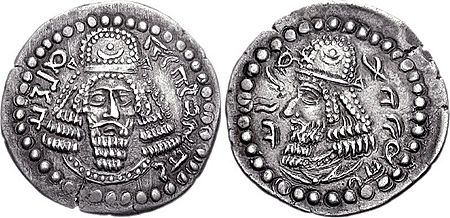
Obv: Bearded facing head, wearing diadem and Parthian-style tiara, legend "The divine Ardaxir, king" in Pahlavi.
Rev: Bearded head of Papak, wearing diadem and Parthian-style tiara, legend "son of the divinity Papak, king" in Pahlavi.
There are different stories about Ardashir's family. Some say he was the son of Papak and grandson of Sasan. Other stories, found in Kar-Namag i Ardashir i Pabagan and Ferdowsi's Shahnameh, say Ardashir was born from the marriage of Sasan (a descendant of Darius III) and Papak's daughter. It seems Ardashir wanted to connect himself to many important families and even gods to make his rule seem more legitimate.
Sasan, Ardashir's ancestor, is a bit of a mystery. Some thought he was a Zoroastrian god, but new research suggests he might have been an old Semitic goddess. It's also possible that Ardashir's family raised Sasan's status to that of a god. Early Islamic sources describe Sasan as a mystic or hermit, possibly from India. This helped Ardashir create a noble and religious family background for himself.
Many foreign sources say Ardashir's family background was not well-known. For example, Agathias tells a story that Papak, a shoemaker, learned from the stars that Sasan would have a great son. So, Papak allowed Sasan to be with his wife, and Ardashir was born. This story is likely made up by opponents of the Sasanians. In an inscription by Shapur I, Sasan is called a nobleman and Papak a king.
Historians debate which of these stories is true. Some find the accounts in Karnamag and Shahnameh more believable, as Ardashir being Sasan's son and adopted by Papak fits with Zoroastrian customs. However, others think these stories were created to make the Sasanian dynasty seem more legitimate. It was common for new rulers to claim links to ancient kings.
Ardashir's family was connected to religious figures. His father was a priest. This suggests Ardashir might not have come from a royal family, but from a religious one. This religious connection allowed him to claim that he received his royal ring directly from Ahura Mazda, which was a new idea for Persian kings.
Pars Before Ardashir
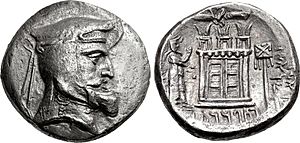
Pars was the region where the Sasanian movement began. By the 3rd century AD, it had lost its former glory. A new city, Istakhr, grew near the ruins of Persepolis, an old Achaemenid capital burned by Alexander the Great. Even though local kings in Pars used famous Achaemenid names like Darius and Ardashir, it was almost the only reminder of their past greatness.
These local governors of Pars saw themselves as the true heirs of the Achaemenids. They had accepted the rule of the Parthians for over 400 years, but they always hoped to regain their old power. They believed the Parthians had unfairly taken their right to rule.
Not much is known about Pars during the 400 years it was part of the Seleucid Empire and then the Parthian Empire. Most of what we know comes from coins minted by the local semi-independent kings. These coins show that local kings ruled in Pars after Alexander the Great. The names "Dara" and "Ardashir" on these coins show that some Achaemenid traditions continued in the region.
During the Parthian era, local Persian kings could mint their own coins. They called themselves "Frataraka," which likely meant "governor." Later, they changed their title to "Shah" (king). Their coins showed royal crowns, temples, fire altars, and symbols of the moon, stars, and Ahura Mazda. This shows that the worship of holy fire and Zoroastrian gods continued strongly in Pars, unlike other regions.
A carving at Takht-e Jamshid shows Papak, dressed as a priest, giving a royal ring to his son Shapur. This suggests that the Sasanians took power by force in Pars and wanted to show their independence from the Parthian emperors. It also shows that the Sasanian family held both religious and political power in Pars.
The Parthian Empire's Decline
After the Roman emperor Commodus died in 192 AD, there was a power struggle in Rome. The Parthian emperor, Vologases V, supported one side, but his army was not strong enough. Eventually, the Roman emperor Septimius Severus won and invaded Mesopotamia, taking back some lost regions.
The Parthian Empire was in disarray. Vologases V faced rebellions within his own empire. Later, his son Vologases VI became king, but his brother Artabanus IV challenged his rule. This led to a civil war within the Parthian Empire.
The Roman emperor Caracalla saw this internal conflict as a chance to attack Parthia. He made excuses to start wars, demanding things like the return of fugitives or marriage to Artabanus's daughter. Artabanus refused, and war began in 216 AD. The Romans captured some cities, but the Parthians fought back.
Caracalla was killed in 217 AD, and the new Roman emperor, Macrinus, tried to make peace. But Artabanus demanded a lot, including all of Mesopotamia and compensation for destroyed cities. Macrinus refused, and the war continued, ending in a big battle at Nusaybin. The Romans were defeated. A peace treaty was signed in 218 AD, with Rome paying a large sum to the Parthians.
Around 220 AD, Ardashir I, the local Persian governor, began taking over lands. Artabanus didn't pay much attention until it was too late. Finally, Ardashir defeated Artabanus at the Battle of Hormozdgan, ending the Parthian dynasty and starting the Sasanian Empire. However, some Parthian noble families, like Suren and Ispahbudhan, actually helped Ardashir in his uprising.
Ardashir's Life Story
Early Years and Rise to Power

Ardashir was born in a village called "Tirudeh" near Istakhr in Pars. His grandfather, Sasan, was in charge of the Anahita Temple in Istakhr. When Ardashir was seven, his father, Papak, sent him to be raised by Tiri, the commander of Fort Darabgard. After Tiri died, Ardashir became the new commander.
Papak, a priest of the Anahita Fire Temple, gathered local Persian warriors. The Parthian king, Vologases V, was weak due to Roman invasions. Papak probably rebelled and united most of Pars under his rule.
Ardashir began his uprising from Ardashir-Khwarrah (modern Firuzabad), far from the Parthian capital. His first inscription in Firuzabad shows him receiving the royal ring from Ahura Mazda, surrounded by his supporters. Ardashir expanded his rule by defeating local kings. According to some accounts, Ardashir asked Papak to rebel against Gochihr, the governor of Istakhr, and Papak killed him. Papak then asked Artabanus IV for permission to appoint his other son, Shapur, as governor. Artabanus declared Papak and Ardashir outlaws.
Papak died, and Shapur became king. A conflict started between Ardashir and Shapur. Shapur then died accidentally when a stone fell on his head. After this, Ardashir's brothers gave him the throne, and he became the Persian Shah. Many suspect Ardashir or his followers were involved in Shapur's death, as they benefited from it, but there's no proof.
Papak's image appeared on coins minted by both Shapur and Ardashir. This suggests Papak had already united much of Pars before Ardashir's full rise to power.
Ardashir gained the support of many local kings and landlords. He challenged the Parthian central government by minting his own coins and building new cities. People were unhappy with the Parthians, which helped Ardashir. Governors from places like Beth Garmai and Adiabene helped him.
Ardashir killed important figures in Darabgard to strengthen his power. He then conquered Kerman and all of Pars, including the Persian Gulf coast. He built a palace and a fire temple in Gor (modern Firuzabad), whose ruins still exist. He appointed one of his sons, also named Ardashir, as governor of Kerman.
The Parthian emperor Artabanus ordered the governor of Susa to attack Ardashir. But Ardashir defeated and killed the governor of Spahan (Isfahan), then moved to Khuzestan and killed the governor of Susa. He also conquered Characene.
Finally, in the Battle of Hormozdgan on April 28, 224, Ardashir killed Artabanus, ending the Parthian dynasty. This date is confirmed by an inscription from Shapur I. After Artabanus's death, Ardashir continued to expand his kingdom, forcing or conquering many large Parthian noble families.
Later sources emphasize the Sasanians' dislike for everything Parthian. Ardashir had to build his new government using some Parthian foundations, but the hatred for the Parthians continued in later Sasanian rulers. This suggests the Parthians might have been harsh rulers, which made Ardashir's conquest easier.
After Becoming King
Historians disagree on the exact year Ardashir was crowned. Some say April 28, 224, others April 6, 227, or 226 in Ctesiphon.
By taking the title Shahanshah (King of Kings), Ardashir showed his ambition to rule a large empire. He tried to conquer Hatra but failed. Then he focused on eastern lands, taking control of large Parthian territories and noble families. The exact borders of his empire are hard to know, but it likely stretched from the Roman borders in the west to the Kushan and Turan empires in the east, and parts of the Persian Gulf coast in the southwest.
Wars with Rome
The first major clash between the new Sasanian Empire and Rome happened around 230 AD. The Persians attacked Roman-held regions in Northern Mesopotamia. Ardashir tried to capture Nusaybin, a Roman fortress, but failed. Sasanian riders also attacked parts of Syria and Cappadocia.
The Romans tried to make peace, but Ardashir refused. In 232 AD, the Roman emperor Severus Alexander reluctantly fought the Persians. Roman forces attacked Armenia and Southern Mesopotamia. While they had some success in Armenia, the southern forces didn't achieve much.
This first war between the Sasanians and Romans ended without a clear winner for Rome. Alexander celebrated it as a victory in Rome, but both sides suffered many losses. Later Persian sources don't mention this war, possibly because Ardashir considered it shameful.
No peace treaty was signed, but the Roman borders remained peaceful for a few years. Ardashir was likely more interested in capturing Hatra, a wealthy trading city. Hatra resisted for a long time, falling only in 240 AD. Its fall might have led to new wars with Rome under Emperor Gordian III.
A romantic story is told about Hatra's fall: The city king's daughter fell in love with Shapur I, Ardashir's son. She opened the city gates for him. But after the city was captured, Shapur had her killed because she betrayed her kind father.
Final Years and Successor
The last years of Ardashir's life are not very clear. His son, Shapur I, likely became a co-ruler on April 12, 240 AD. This is known from inscriptions that show Shapur participating in royal duties. Coins from this time show both Ardashir and Shapur. Ardashir probably made Shapur his co-ruler to avoid problems with succession, as he had other sons who might have wanted the throne.
Ardashir and Shapur ruled together until early 242 AD. Shapur might have been crowned twice: once as co-ruler in 240 and again as sole ruler in 243, but it's more likely he was crowned only once in 240.
How Ardashir Ruled
Centralizing Power
The Sasanian Empire had two main forces: the central power, led by the "shahanshah" (king of kings), who wanted more control; and the powerful landlords, who tried to keep their own power.
At first, Sasanian rule was similar to the Parthian system, relying on local nobles and clans. But Ardashir realized he needed to centralize power to expand his empire. He wanted to remove local governors and create a strong central government with an organized system. Even though the Sasanian government started like the Parthian one, it quickly moved towards centralizing power. In the early Sasanian era, Iran was a union of kingdoms and noble landlords, each with some independence.
Building Cities
The first Sasanian kings, including Ardashir, built or rebuilt many cities. These "royal cities" were military bases in newly conquered lands. They became centers for government officials and collected taxes directly for the empire. This was different from the Parthian era, where many cities were more independent.
Here are some cities believed to have been built by Ardashir:
| Sasanian Name | Islamic Name | Region | |
|---|---|---|---|
| 1 | Ardashir-Khwarrah | Firuzabad | Fars |
| 2 | Rew-Ardashir | Reyshahr | Fars |
| 3 | Ram-Hormozd-Ardashir | Ramhormoz | Khuzestan |
| 4 | Hormozd-Ardashir | Ahvaz | Khuzestan |
| 5 | Ostad-Ardashir | Characene | Khuzestan |
| 6 | Vahshatabad-Ardashir | Basra | Khuzestan |
| 7 | Veh-Ardashir | Beharsir | Mesopotamia |
| 8 | Buz-Ardashir | Mosul | Mesopotamia |
| 9 | Veh-Ardashir (Kerman) | Bardsir | Kerman |
| 10 | Tan-Ardashir | Madinat-ol-Khat | Bahrain |
Some historians doubt that all these cities were built by Ardashir himself. His son, Shapur I, also built cities named after his father to honor him.
Government Ideas and Iranian Identity

The ruins of Pasargadae and Takht-e Jamshid were constant reminders of Pars's past glory. Even though knowledge of the great Achaemenid Empire was mostly forgotten, local Persian rulers continued some of their traditions. For example, their coins showed a connection to the Achaemenids.
Ardashir played a big part in developing the idea of royal power. He presented himself as a worshiper of Ahura Mazda and someone with divine glory. He claimed his right to rule came from mythical Iranian kings. He also spread ideas against the Parthians, saying they were not true Iranians. This shows how important the Achaemenid legacy was to the first Sasanian kings.
Some historians believe the Sasanians knew about the Achaemenids but chose to link themselves to the mythical Kayanian dynasty instead. They did this to create a sacred history for their rule. Ardashir carved pictures in Firuzabad, Naqsh-e Rustam, and Naqsh-e Rajab to celebrate his victories. In the Naqsh-e Rustam carving, Ardashir and Ahura Mazda are on horseback, with the bodies of Artabanus and Ahriman under their horses' hooves. This image suggests Ardashir believed his rule over the land, called "Iran" in inscriptions, was given by God.
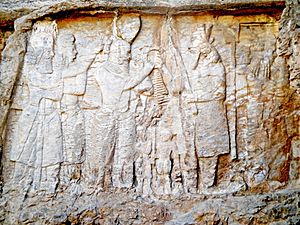
Choosing places like Naqsh-e Rustam (where Achaemenid kings were buried) for carvings, and linking his family to Achaemenid ancestors, shows an interest in the Achaemenids in the early Sasanian period. Sasanian sources also show an aggressive stance against Rome, aiming to restore the past glory that they believed Rome had taken. Al-Tabari mentions that Ardashir claimed to be seeking revenge for Darius III, who was defeated by Alexander the Great. Roman historians also noted the Sasanians' desire to return to the Achaemenid Empire's greatness.
Some historians believe these claims were propaganda by the Romans or later Sasanian writers. However, Ardashir and his son Shapur I clearly wanted to conquer Roman lands. This desire might have been based on a mythical story where the world was divided among three sons, with Iran going to Iraj, and Rome to Salm. The Sasanians saw themselves as Iraj's descendants and the Romans as Salm's, which explained their territorial claims.
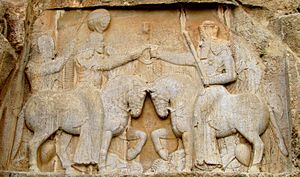
The Sasanian family tree in Kar-Namag i Ardashir i Pabagan links Sasan to Darius's descendants and local Persian kings. Later, in the fifth century, the Sasanians linked their lineage to the mythical Kayanian kings, adding "Kay" to their titles.
It's not clear if Ardashir himself made all these claims or if they were added later to make his rule seem more legitimate. However, Ardashir definitely aimed to restore and expand the Achaemenid Empire's successes. But the Sasanians' knowledge of the Achaemenids was likely vague. Some historians believe that early Sasanian history was rewritten later to make Ardashir seem like an ideal ruler.
Religious Policy
Papak, Ardashir's father, was the chief priest of the Anahita temple in Istakhr. With Ardashir's rise, religion became very important in Iran. Papak's religious influence might have helped him take power from Gochihr, who didn't care about the fire religion.
A carving at Takht-e Jamshid shows Papak and his son Shapur. Papak is dressed as a priest, holding a sword and tending a fire, while Shapur receives a royal ring. This suggests that the Sasanian family held both religious and royal power. On his coins, Ardashir, who replaced his brother Shapur, wears a crown similar to Shapur's, and his father Papak's image is on the back.
Zoroastrianism was the main religion supported by the Sasanians from Ardashir's time. While no Zoroastrian religious leader had a very high rank in Ardashir's court, it seems the first steps to make Zoroastrianism the state religion happened during his rule. Old traditions from the Achaemenid, Greek, and Parthian eras were combined.
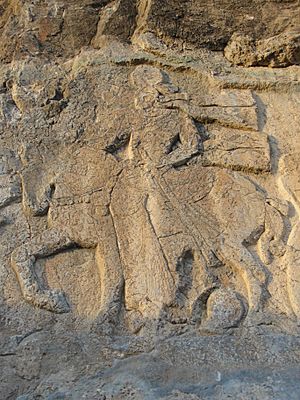
On his coins and in his inscription at Naqsh-e Rustam, Ardashir called himself a worshiper of Ahura Mazda and from the line of gods. His crown, which looks like Ahura Mazda's crown in some carvings, and the phrase "...looks similar to the gods" on his coins, show his claim to a divine place. The fire temple symbol on the back of his coins shows his religious beliefs. His carvings at Firuzabad, Naqsh-e Rustam, and Naqsh-e Rajab show him close to Ahura Mazda. This connection to Ahura Mazda, called khvarenah, showed that his rule was legitimate.
Ardashir also built fire temples and gave them money, and he supported Zoroastrian religious texts to gain legitimacy. A special fire temple called "Ardashir's Fire" was founded early in his reign.
Ardashir's policies were difficult for non-Zoroastrian groups. While Jews and other religions had some freedom under the Parthians, Ardashir and his son Shapur I tried to limit their independence. This was probably to expand Zoroastrian society. However, Syriac-speaking Christians were treated with more tolerance, and their population grew. The prophet Mani did not begin his teachings until after Ardashir's death, possibly because he thought Shapur would be more open to his ideas.
Ardashir in Stories
In Iranian historical stories, Ardashir is shown as a brave, wise, and strong man. He was persistent and fought alongside his warriors. These stories say he succeeded because he was from the line of ancient Iranian kings and chosen by the gods to rule Iran. However, it's likely that some of these heroic details were added later to make the Sasanian rule seem more justified.
The Letter of Tansar says Ardashir wanted to get revenge on the Romans for Alexander the Great's defeat of Darius III. This text was meant to stir up Iranian national feelings. It shows that Iranians had a strong sense of national identity and saw themselves as different from other peoples. That's why lands conquered by Iranians were never called "Iran" but "Aniran" (non-Iran).
Ardashir's Rock Carvings
The Sasanian art of carving pictures into rocks, called petroglyphs, began with Ardashir. His first three carvings have different styles. But his fourth carving, showing his coronation at Naqsh-e Rustam, has clear features that were repeated in the carvings of Shapur I and later kings.
Ardashir's Coins
The coins minted during Ardashir's time can be divided into three main groups:
- The first group shows Ardashir's full face on one side and a profile of his father, Papak, on the other. The coins say "Ardashir Shah" and "His Majesty Papak Shah."
- The second group shows Ardashir's profile, wearing a hat or crown, facing right. On the back, there's a symbol of a fire temple's firebox, which is common on Sasanian coins. These coins say, "The worshiper of Mazda, his majesty Ardashir the Iranian shahanshah who has his face from the gods." This shows Ardashir's religious beliefs.
- The third group shows Ardashir's picture in front of his son, Shapur I. The coins say, "Shapur the Iranian shah who has his face from the gods" and "Ardashir's fire." The firebox is also on the back.
The firebox symbol on the coins represents a royal fire lit at the beginning of each king's reign. Its base looks similar to the Achaemenid throne. This shows Ardashir wanted to present himself as the rightful heir of the Achaemenids and a devout Zoroastrian. His early coins had a crown similar to Parthian kings, but later he used a crown with a globe on top, decorated with a silky net and hanging bands.
The similarity of Ardashir's coins to those of earlier local Persian governors shows a continuation of Persian traditions. However, this doesn't mean Ardashir was exactly like those earlier rulers.
Ardashir's Legacy
Ardashir I and Khosrow I are two Sasanian kings known for their wise sayings and advice, which are quoted in many Arabic and Persian books. One of the most important works attributed to Ardashir is his "testament."
Ardashir's Testament
Ardashir's Testament is a book of political advice from Ardashir to future Iranian kings. It contains lessons he believed were necessary for ruling the kingdom.
The original Middle Persian text of this testament is lost, but several Arabic translations exist. It was very famous in the Islamic era and is mentioned in many history and literature books. For example, Khosrow I was said to have followed Ardashir's advice from this testament.
Ardashir's Book on Government Principles
Another book attributed to Ardashir discusses the basics of government. It covers topics like warriors, writers, judges, invasions, accepting ambassadors, building cities, his strategy for noble families, complaints, and developing lands. It's not known if this book was directly translated from Middle Persian. Some believe an Arabic writer put it together from different sources, as it shows some Islamic influences. However, since it's mentioned in Shahnameh, it likely existed in Khwaday-Namag and might have had some Islamic ideas added during translation.
Ardashir-Khwarrah
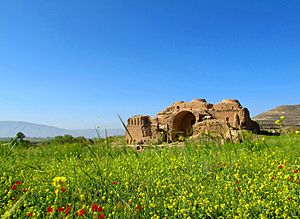
Ardashir-Khwarrah was one of five Iranian villages built by Ardashir during the Sasanian era. Its name means "Ardashir's magnificence." The town was probably built after Ardashir's victory over Artabanus in 224 AD. It was built near Ardashir's palace, and it's said he built five fire temples there. The city of Gur, as it was known, was later renamed Firuzabad. Ardashir-Khwarrah was an important military base and a place where Sasanian coins were made.
The city's design was inspired by Darabgard, with circular walls, a double muddy wall, and a trench. Two main roads divided the city into four sections with four main gates named Mehr, Bahram, Hormoz, and Ardashir.
See Also
 In Spanish: Ardacher I para niños
In Spanish: Ardacher I para niños
- Inscription of Ardashir-e Babakan and Hormozd
- Kārnāmag-ī Ardaxšīr-ī Pābagān



